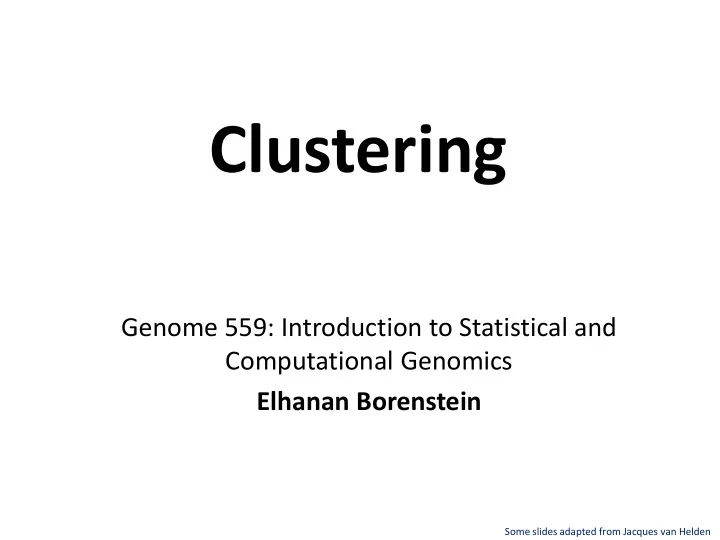

Clustering Genome 559: Introduction to Statistical and Computational Genomics Elhanan Borenstein Some slides adapted from Jacques van Helden
A quick review Small vs. large parsimony Fitch’s algorithm: 1. Bottom-up phase : Determine the set of possible states 2. Top-down phase : Pick a state for each internal node Searching the tree space: Exhaustive search, branch and bound Hill climbing w/ Nearest-Neighbor Interchange Branch confidence and bootstrap support
The clustering problem gene x [0.1, 0.0, 0.6, 1.0, 2.1, 0.4, 0.2, 0.3, 0.5, 0.1, 2.1] gene y [0.2, 1.0, 0.8, 0.4, 1.4, 0.5, 0.3, 2.1, 1.2, 3.4, 0.1]
The clustering problem The goal of gene clustering process is to partition the genes into distinct sets such that genes that are assigned to the same cluster are “similar”, while genes assigned to different clusters are “non - similar”. gene x [0.1, 0.0, 0.6, 1.0, 2.1, 0.4, 0.2, 0.3, 0.5, 0.1, 2.1] gene y [0.2, 1.0, 0.8, 0.4, 1.4, 0.5, 0.3, 2.1, 1.2, 3.4, 0.1]
The clustering problem A good clustering solution should have two features: 1. High homogeneity : homogeneity measures the similarity between genes assigned to the same cluster. 2. High separation : separation measures the distance/dis- similarity between clusters. (If two clusters have similar expression patterns, then they should probably be merged into one cluster).
Why clustering
Why clustering Clustering genes or conditions is a basic tool for the analysis of expression profiles, and can be useful for many purposes, including: Inferring functions of unknown genes (assuming a similar expression pattern implies a similar function). Identifying disease profiles (tissues with similar pathology should yield similar expression profiles). Deciphering regulatory mechanisms: co-expression of genes may imply co-regulation. Reducing dimensionality.
Why is clustering a hard computational problem?
One problem, numerous solutions Many algorithms: Hierarchical clustering k-means self-organizing maps (SOM) Knn PCC CLICK There are many formulations of the clustering problem; most of them are NP-hard (why?) . The results (i.e., obtained clusters) can vary drastically depending on: Clustering method Parameters specific to each clustering method (e.g. number of centers for the k-mean method, agglomeration rule for hierarchical clustering, etc.)
Different views of clustering …
Different views of clustering …
Different views of clustering …
Different views of clustering …
Different views of clustering …
Different views of clustering …
Measuring similarity/distance An important step in many clustering methods is the selection of a distance measure ( metric ), defining the distance between 2 data points (e.g., 2 genes) “Point” 1 : [0.1 0.0 0.6 1.0 2.1 0.4 0.2] : [0.2 1.0 0.8 0.4 1.4 0.5 0.3] “Point” 2 Genes are points in the multi-dimensional space R n (where n denotes the number of conditions)
Measuring similarity/distance So … how do we measure the distance between two point in a multi-dimensional space? B A
Measuring similarity/distance So … how do we measure the distance between two point in a multi-dimensional space? p-norm Common distance functions: The Euclidean distance 2-norm (a.k.a “distance as the crow flies” or distance). The Manhattan distance 1-norm (a.k.a taxicab distance ) The maximum norm infinity-norm (a.k.a infinity distance ) Correlation (Pearson, Spearman, Absolute Value of Correlation, etc.)
Metric matters! The metric of choice has a marked impact on the shape of the resulting clusters: Some elements may be close to one another in one metric and far from one anther in a different metric. Consider, for example, the point (x=1,y=1) and the origin (x=0,y=0). What’s their distance using the 2 -norm (Euclidean distance )? What’s their distance using the 1 -norm (a.k.a. taxicab/ Manhattan norm)? What’s their distance using the infinity-norm?
Hierarchical clustering
Hierarchical clustering Hierarchical clustering is an agglomerative clustering method Takes as input a distance matrix Progressively regroups the closest objects/groups Tree representation branch Distance matrix object 1 c1 node object 1 object 2 object 3 object 4 object 5 object 5 c3 object 4 c4 c2 object 1 0.00 4.00 6.00 3.50 1.00 object 2 object 2 4.00 0.00 6.00 2.00 4.50 object 3 object 3 6.00 6.00 0.00 5.50 6.50 root object 4 3.50 2.00 5.50 0.00 4.00 object 5 1.00 4.50 6.50 4.00 0.00 leaf nodes
mmm… Déjà vu anyone?
Hierarchical clustering algorithm 1. Assign each object to a separate cluster. 2. Find the pair of clusters with the shortest distance, and regroup them into a single cluster. 3. Repeat 2 until there is a single cluster. The result is a tree, whose intermediate nodes represent clusters Branch lengths represent distances between clusters
Hierarchical clustering 1. Assign each object to a separate cluster. 2. Find the pair of clusters with the shortest distance, and regroup them into a single cluster. 3. Repeat 2 until there is a single cluster. One needs to define a (dis)similarity metric between two groups . There are several possibilities Average linkage: the average distance between objects from groups A and B Single linkage: the distance between the closest objects from groups A and B Complete linkage: the distance between the most distant objects from groups A and B
Impact of the agglomeration rule These four trees were built from the same distance matrix, using 4 different agglomeration rules. Single-linkage typically creates nesting clusters Complete linkage create more balanced trees. Note: these trees were computed from a matrix of random numbers. The impression of structure is thus a complete artifact.
Hierarchical clustering result Five clusters
The “philosophy” of clustering - Summary “ Unsupervised learning ” problem No single solution is necessarily the true/correct! There is usually a tradeoff between homogeneity and separation: More clusters increased homogeneity but decreased separation Less clusters Increased separation but reduced homogeneity Method matters; metric matters; definitions matter; In most cases, heuristic methods or approximations are used.
What are we clustering? We can cluster genes, conditions (samples), or both.
Clustering in both dimensions
Correlation as distance Another approach is to use the correlation between two data points as a distance metric. Pearson Correlation Spearman Correlation Absolute Value of Correlation
Recommend
More recommend